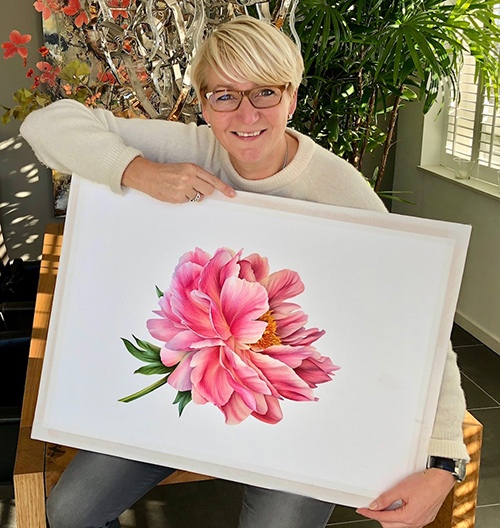
The Dancing Iris by Ingrid Elias
Ingrid Elias is a Dutch botanical artist who is known for her heightened illustration of flowers. She combines a touch of free expression to render a unique style all her own. Her use of colors are brilliant, not only rich but also conveying dynamic levels of contrast in textures thus giving vivid life to the subjects themselves. Her skill at illustrating the iris, especially the bearded iris, demonstrates her ability to bring out the most elegant side of flowers, like dancers swaying in the wind.
Before becoming fully dedicated to watercolor painting in 2018, Ingrid joined various workshops and lessons. Once she mastered techniques, her art career took off and now people love her style of portraying flowers. For the past decade, she has continuously exhibited her art works at museums and art galleries ( such as The Shirley Sherwood Gallery, Kew Gardens, London, Noordbrabants Museum, Historic center of ‘s-Hertogenbosch, NL, Museum De Zwarte Tulp, Lisse, NL, Flower Art Museum, Aalsmeer, NL, etc.) in the Netherlands. We are very pleased to be able to feature her exquisite botanical art in the following interview.
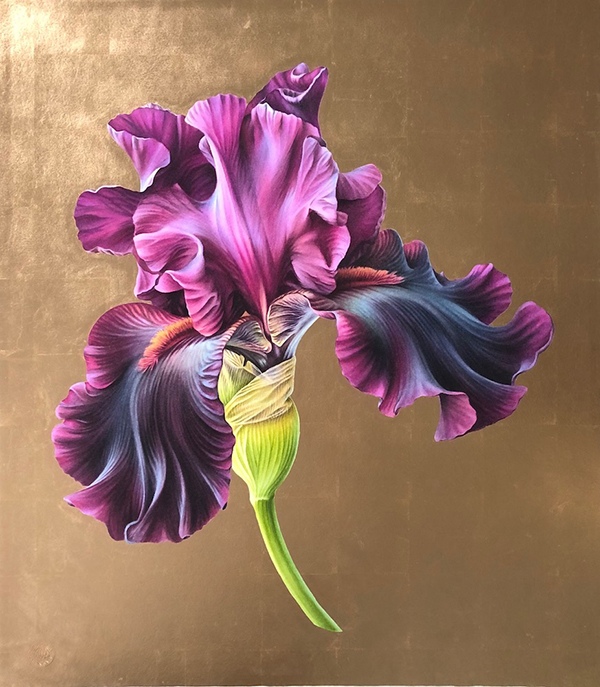
Q: Your botanical art is absolutely exquisite. Please share with us the path that you took to become such a fine artist.
A: Thank you so much for your kind words. They are so encouraging. The path to becoming an artist revealed itself more or less subconsciously. When I had my first introduction to the medium of watercolor in 2009 I could not have suspected that it would lead me to the stage where I am now. At the time I was working as an administrative assistant and I felt the need to challenge myself creatively. So I decided to take a watercolor painting course in 2009.
During that course, it soon became clear that my preference is for detailed work and I like to spend hours fiddling with the finest brushes. When I visited a museum that exhibited botanical art, I was so fascinated by the detailed depiction of the flowers in watercolor that I went looking for an opportunity to learn the basics of botanical drawing and painting. I soon ended up with the Dutch Society of Botanical Artists and I signed up for a workshop by Anita Walsmit Sachs. She taught me the basics of botanical art and also encouraged me to improve myself. In addition, I attended workshops by Anne Marie Evans, Jenny Phillips, and Helen Allen. My confidence grew and I developed my own way of working. As a result, in 2018 I decided to pursue a career as a botanical artist.
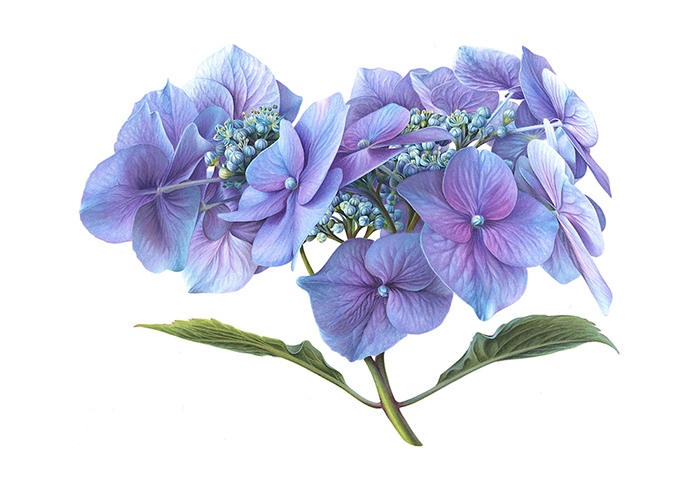
Q: When painting flowers, what elements do you focus on that make your paintings so outstanding?
A: It is the beauty of the flower itself that inspires me to show her as beautiful as possible. It evokes a responsibility to show her at her prettiest. To be able to achieve the most truthful result I do a comprehensive study in advance even before my brush touches the paper. It all starts with looking for the right species and picking out the most striking flowers. Each flower has its own specific characteristics and elements to focus on.
It is a challenge to bring that out in every flower I paint. With a lot of patience, perseverance, and the urge for perfection I aim to put the essence of the flower on paper and create a new reality.
Q: Conventional botanical art emphasizes the scientific accuracy of plants for the purpose of identification. How do you balance the aesthetic value versus scientific value in your botanical paintings?
A: As a botanical artist I paint my flowers true to nature. To achieve a truthful result, I study the flower extensively. By taking the flower apart and studying each part individually,
I strive to understand how it has grown. This extensive study allows me to become familiar with the biological characteristics of the specific flower. In the next phase, when I start drawing the flower, I allow myself some artistic freedom in order to achieve an attractive composition, but I always stay true to nature. By showing my flowers ‘larger than life’, I seek to seduce the viewer to be overwhelmed by the flower and to change their way of looking.
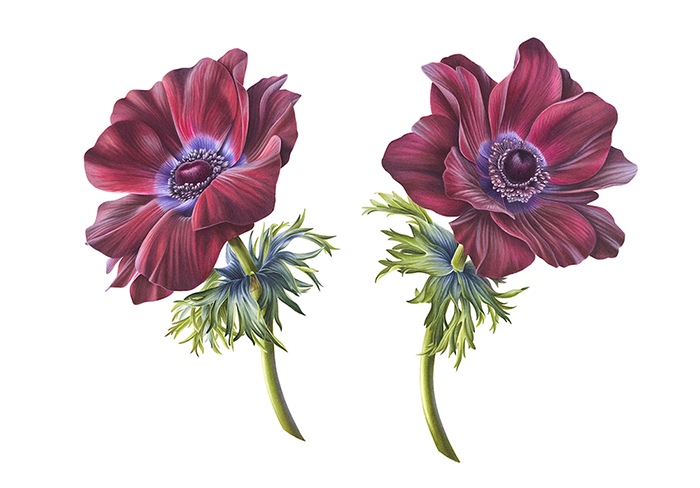
Q: What type of plants/flowers are your favorite subjects and why?
A: A few years ago, I visited an iris nursery and I was allowed to bring arm fulls of beautiful irises to my studio. I have now painted four irises and I think many more will follow. The bearded iris in particular is a beautiful, artistic flower that fascinates me enormously. It is so beautiful to see when the flower bud opens and the leaves curl gracefully. Sometimes they look like ballet dancers.
In general, flowers are a very rewarding subject. They always fascinate me and I keep discovering new beautiful species that beg to be portrayed.
Q: What is the primary medium you paint with and why?
A: I primarily paint with watercolor. The bright colors were the reason for me to get started with this medium and it turns out to be very suitable for painting flowers. It is also a challenging medium and it leaves little room for mistakes but gives me the ability to work in very fine detail. By building up my painting in many thin layers, I slowly build towards the expressive colors and natural shapes that characterize the flower.
Occasionally I work on a special edition. They are based on the original watercolor painting and enriched with precious materials like gold or palladium.
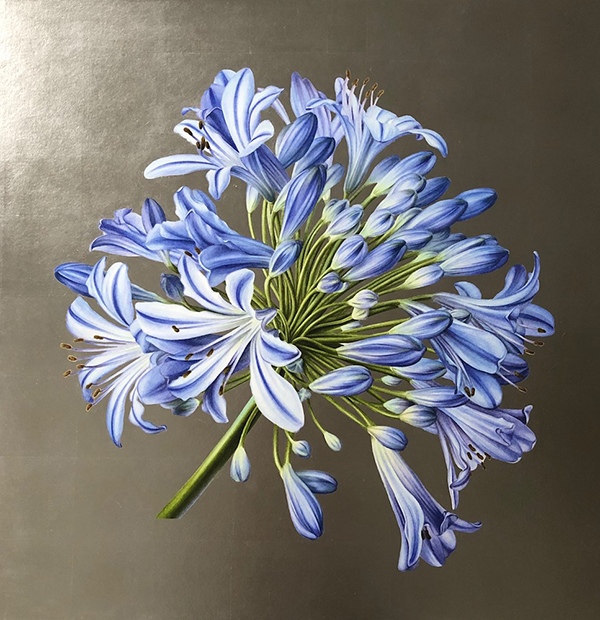
Q: In what ways has classical art influenced you?
A: While I am building on a centuries-old tradition as a botanical artist, I am probably more influenced by modern art. Although true-to-life reproduction leaves little room for artistic freedom, I seek to display the flower in a contemporary way. I do not paint what I see, but what I want to show you.
Q: What advice would you give to people who are interested in painting botanical art?
A: Take your time and enjoy the process. Find the most beautiful flower that inspires you and take your time to study it. Love the process of drawing and before every painting session, just sit down and study the part you are going to paint. If you take the time to absorb the details, you will see so much more. Often colors and details become visible that you would not have noticed otherwise. And above all, have fun drawing and painting! Don’t set the bar too high, but enjoy the process and the result will come naturally.
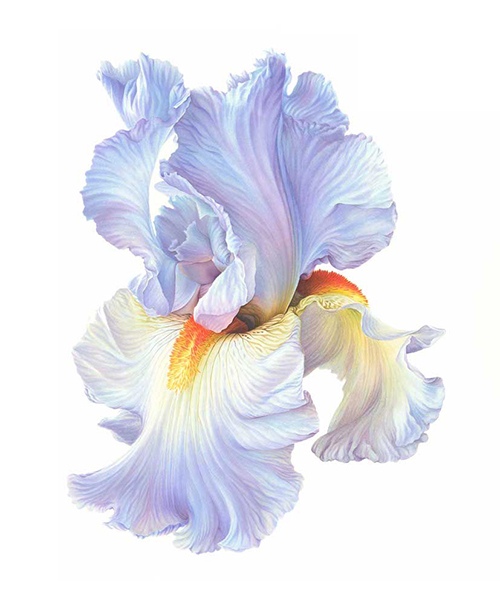
Q: Do you have any future plans or projects that you would like to share with our readers?
A: I still have many flowers on my list that I would like to paint. Each of them will challenge me in their own way, with their own characteristics and specific colors. With each flower, I will enjoy the fascinating process of making them sparkle on paper and with each flower I go one step further in my artistic journey. You are more than welcome to follow me on this journey via my Instagram page @ingrid.elias_botanical.art
We thank Ingrid for sharing her beautiful paintings and inspiring journey of becoming an extraordinary botanic artist. We wish her great success in her art career.
Ingrid’s Website and Instagram
